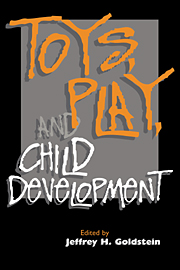Book contents
- Frontmatter
- Contents
- Acknowledgments
- List of contributors
- Introduction
- 1 Imaginative play and adaptive development
- 2 Play, toys, and language
- 3 Educational toys, creative toys
- 4 The war play debate
- 5 War toys and aggressive play scenes
- 6 Sex differences in toy play and use of video games
- 7 Does play prepare the future?
- 8 Play as healing
- References
- Name index
- Subject index
4 - The war play debate
Published online by Cambridge University Press: 07 October 2009
- Frontmatter
- Contents
- Acknowledgments
- List of contributors
- Introduction
- 1 Imaginative play and adaptive development
- 2 Play, toys, and language
- 3 Educational toys, creative toys
- 4 The war play debate
- 5 War toys and aggressive play scenes
- 6 Sex differences in toy play and use of video games
- 7 Does play prepare the future?
- 8 Play as healing
- References
- Name index
- Subject index
Summary
The debate about war toys, though not new, has taken on new life over the last decade. The deregulation of television in the United States in the 1980s, the loosening of restrictions in the United Kingdom, and the coming of satellite and cable television, together with the development of program-length commercials and the associated marketing of war toys, have reawakened fears of many parents and teachers about this kind of play. A similar debate in the 1960s (the Vietnam War period in the United States) was documented by Andreas (1969). Advertisements for modern war toys in the magazines Toys and Novelties and Sears Christmas Book nearly tripled over the period 1961–64/5. Andreas claimed that this was an anticipation of demand rather than a response to it, and that following protests by parents and educators, advertising fell to earlier levels by 1967.
The more recent wave of concern has provoked two books by Nancy Carlsson-Paige and Diane Levin. In the first book, The War Play Dilemma: Balancing Needs and Values in the Early Childhood Classroom (1987), they contrast the developmental view that play, including war play, is a primary vehicle through which children work on developmental issues, with the sociopolitical view that children learn militaristic political concepts and values through war play. They advocate that teachers and parents, rather than banning war play, should intervene to channel it into more educational and acceptable forms.
- Type
- Chapter
- Information
- Toys, Play, and Child Development , pp. 67 - 84Publisher: Cambridge University PressPrint publication year: 1994
- 6
- Cited by



